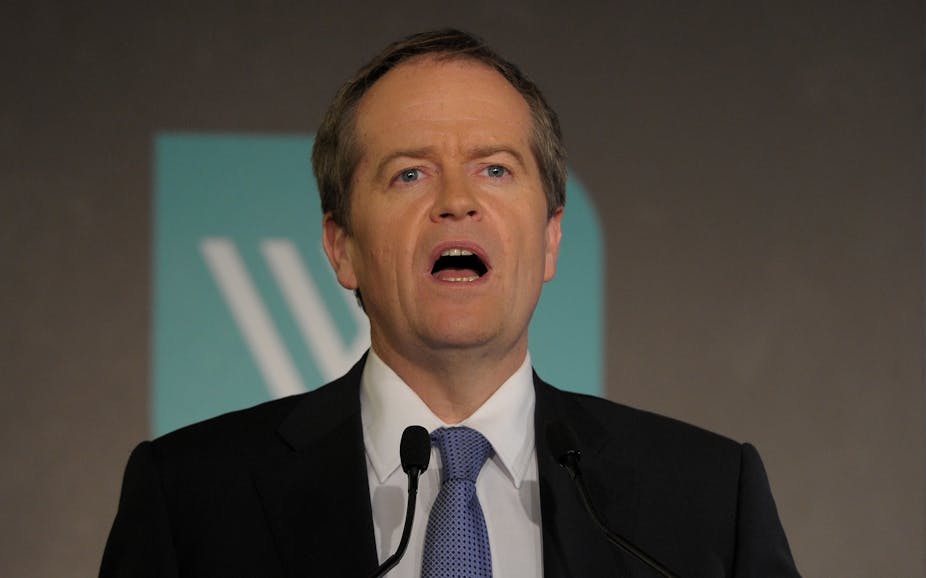Federal Labor leader Bill Shorten has outlined his vision for a rejuvenated Labor Party. His speech earlier this week was a call to arms for the reform of federal Labor’s organisational rules. While Shorten’s objective of producing an “inclusive”, “membership-based party” is hard to argue against in theory, achieving it in practice is likely to prove fraught.
Although the speech was light on detail and did not set a timetable for action, the most important ideas contained within it included:
reducing the barriers to individuals joining the party by introducing a “one-click” online model and reducing the cost of national membership;
-
removing the requirement that prospective party members be affiliated to a union;
reforming federal pre-selection processes to increase the weight accorded to ordinary members in the selection of Labor candidates, including the use of community-based pre-selection methods in non-held lower house seats;
altering the composition of delegates at National Conference, the party’s supreme governing body, so as to privilege individuals over union delegates; and
advocating for all state and territory Labor leaders to be elected by a combined vote of caucus and the membership.
As Shorten acknowledged, party reform is an uncertain venture. Changing party rules will inevitably make losers out of winners. Those who find themselves on the wrong side of the reform agenda are likely to seek to frustrate it by any means possible.
An added risk is that the conflicts that the reform putsch will produce will spill over into the public arena with damaging consequences for the Labor Party’s image.
Victim of its own success
It is not clear that organisational reform can fix the problems at the heart of Labor’s malaise. Labor’s main challenge is fundamentally sociological in nature. The ALP, like many other social democratic parties in industrialised democracies, is a victim of its own policy successes.
Over the decades, Labor has addressed some of the worst excesses of societal disadvantage and inequality when in government. In doing so, it has transformed both the life opportunities but also the political and social expectations of Labor’s former working-class base.
This has left Labor with a constituency that is fractured between a progressive and traditional cohort. The gulf between these constituencies is wide. Increasing the party’s membership is unlikely to bridge the policy and cultural divide that separates these voting segments.
The unions problem
Some of the reform sentiments within Shorten’s speech might also prove disadvantageous to Labor’s actual interests. For example, Shorten was at great pains to put distance between Labor and the unions, making clear that the modern Labor Party he wanted was:
…not the political arm of anything but the Australian people.
Shorten justified this distancing from the union movement on the grounds that the role of the unions within the party “has developed into a factional, centralised decision-making role”. While the union connection is clearly messy and embarrassing for the party on occasions – such as in the disastrous WA Senate election – it is also a relationship that remains beneficial to Labor. That is, the relationship between Labor and unions is not just historical but is ongoing.
The union movement has long served as a recruiting and training ground for many aspiring Labor politicians. This includes Shorten himself, who was national secretary of the powerful Australian Workers’ Union (AWU) before entering parliament. The unions also mobilise for the party at elections and make a substantial financial contribution to ALP coffers.
A faction-free Labor Party?
It is far from clear that a larger, more inclusive party will produce a factionless party, free from the destructive power struggles that can grip this – and any other – organisation.
It is difficult to prevent power from aggregating around cliques in any organisation. The larger the party grows in terms of its numerical size, the stronger are the incentives for power to collect around individuals and groups. The rank and file can become disempowered by the sheer size of the organisation.
Also, reforms aimed at breaking up extant power groupings may only temporarily frustrate them. As labour historian Bradley Bowden recently noted on The Conversation, union bosses are likely to circumvent any efforts to significantly sideline them by encouraging their members to join as individuals.
Shorten is not the first Labor leader to aspire to reforming the party organisation, nor is he is likely to be last. He is staking his leadership on achieving a modernised Labor Party and is leveraging his status as the first member-elected party leader as the basis for his mandate to pursue these reforms.
But as a factional warrior of the Victorian branch of the Labor Party who profited from many of the rules that he now seeks to challenge, Shorten’s credibility on this matter might be somewhat tarnished.
Further reading: The Conversation’s recent series on Labor’s future.

